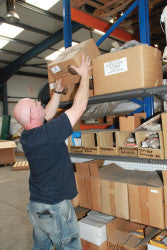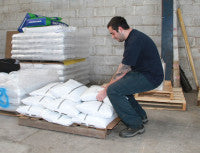Manual handling - how to lift correctly
 I have been informed, on the grapevine, that a local authority has carried out a risk assessment and, as a result, reduced the lifting weight of objects, by its staff, down to fifteen kilogrammes (15kg) Is that right or wrong, or just questionable?
I have been informed, on the grapevine, that a local authority has carried out a risk assessment and, as a result, reduced the lifting weight of objects, by its staff, down to fifteen kilogrammes (15kg) Is that right or wrong, or just questionable?
HSE - Health and Safety Executive - along with other safety and medical organisations have, for years, given all industries guidelines on safe methods, techniques and weights. Getting to Grips With Manual Handling HSE being a prime example.
Industries would take those guidelines, and carry out a risk assessment, by looking at all the hazards for the task involved. This would then be rated on:
- level of potential risk to the individuals involved
- methods of carrying out the task (with equipment if required) to reduce the physical manual lift (is that still a PC statement - manual handling?)
What I am concerned about is the lack of training in the task of lifting, and not the weight.
Yes, it is possible to injure yourself in a number of areas of the body, especially the back, by lifting a piece of paper or a pen off the floor, or by sitting in the wrong position, then moving to carry out a small lifting task.
38% of all injuries that keep people away from work for three days or more can be attributed to handling incorrectly.
So, you have been told to bend your knees, keep your back straight, with you head forward, and keep the load close to your body. Then you have to assess the object for weight, size, shape, movement (liquid, powder etc.), the distance you are taking it, what the conditions are around you, what hazards are close by, e.g. something you might trip over, and if you are moving the object inside or taking it outside.
You also have to take into consideration how big you are, how tall or short you are, how mature or young you are, how fit you are, what you are wearing and, actually, do you have the experience etc.?
There are plenty of other questions. Have you any injuries that could affect the lifting techniques you are about to use? Is this going to be more than one lift and, if so, is it over a period of time with constant repetition? Are you trying to show how manly you are in front of your mates (Grrrrrrrrrr) or you can lift as much as any man can? (not meant as a sexist comment).
 There is always the perfect lift, as described in a lot of books and guides, but then there is 'the real world', which tends not to be perfect.
There is always the perfect lift, as described in a lot of books and guides, but then there is 'the real world', which tends not to be perfect.
If you put some of the information together that I have listed, if you assess correctly, if you only lift what you are able, with a good safe technique, taking in to consideration your own physical attributes, you could possibly reduce the risk of injury.
Don't forget, if you are sitting and reaching to even lift paper, a good technique will reduce the chance of injury. Has the position been assessed, is the chair correct for you, have you actually been shown, did you ask? If not, why not!
Making the load lighter will not always reduce the problem, as this could create more repetitive lifting for longer periods.
Also, the smaller or lighter we encourage our industries to pack products, the higher the cost is going to be in time and money.
So, it's not just the weight you need to consider in all areas of manual lifting, in all areas of work, but the way you lift which is the priority.
Am I experienced at lifting? Yes, I am. Do I know what a bad back feels like? Yes, I do.
How did I get a bad back? By not doing something in this article at a particular point in my working life, possibly when I was much younger, and trying to be grrrrrrrrrrrrrrrrrrr.
The extra precautions I now take include wearing a lightweight body harness or a weight lifting belt for repetitive work, especially in a prolonged bent over position such as laying turf, paving or even weeding.
When not working, I perform various stretching exercises to try and keep this mature frame supple.
Would I give a bad back to my worst enemy? No, I wouldn't be that cruel.
I believe it's not the weight, but the lack of consideration to the WAY we lift.
Tips for safe lifting
Plan before you lift. Remove anything that is in the way. Pushing is easier than pulling. Pulling is easier than carrying. Lowering loads causes less strain than lifting.
Get help for heavy or bulky loads. Use equipment like a cart to help when possible.
Warm up your muscles with gentle stretches before you lift. This is very important if you have been sitting for more than fifteen minutes before lifting.
Test the weight of the load first. Be sure that you can handle it safely. A big load of the same weight will put more strain on your body than a small load. Break your load into smaller or lighter loads.
Face the way you need to move. Avoid twisting or side bending. Turn your entire body. Place your feet wide apart to keep your balance.
Hold the load close to your body. Grip the load using your whole hand not just the fingers. Using your whole hand will give you the greatest grip area and strength. Balance your load evenly between both arms.
Lift with as straight a back as is comfortable. Tighten your abdominal (stomach) muscles. Bend your legs so they do the lifting.
Keep the load between shoulder and knee height. Avoid reaching.
Change your position and stretch to relax and rest your tired muscles. You need time to recover your strength between lifts to be able to work safely. Repeated and long lifts are the most tiring. Switch between heavy loads and lighter ones.
Plan where to set the load down. Place loads on raised platform. Leave enough room for your hands to grip the load. Avoid placing loads directly on the floor.
Rest more often when it is hot and humid.
Take more time to warm up your muscles when it is cold.
Take more breaks if you are also using tools or equipment that vibrate.
